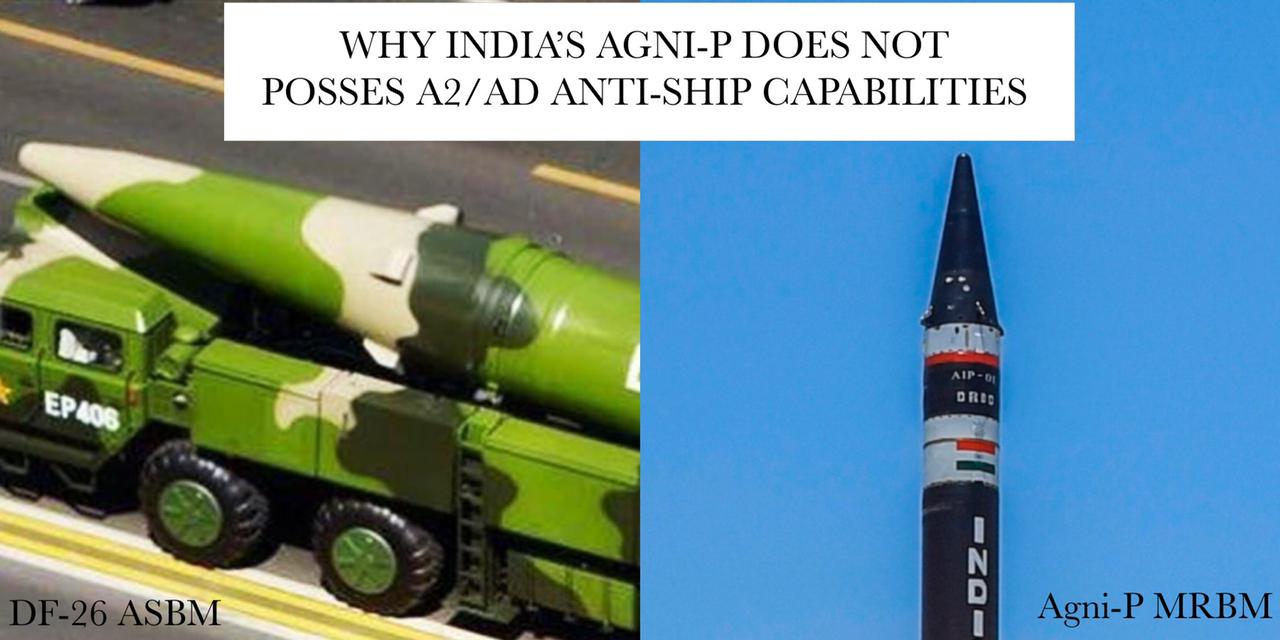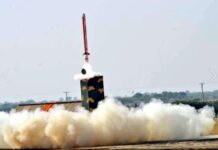I was surprised to see some Indian “military analysts” on Twitter, rather laughably claiming that the medium range ballistic missile Agni-P, currently under development by India’s DRDO, has anti-ship ballistic missile capabilities and will be able to target a Chinese aircraft carrier group “anywhere in the Indian Ocean”. When I saw it first, I laughed out loud as I usually do when I see ridiculous Indian military “fanboys” on Twitter and their claims of the Indian military (India’s amateur as well as professional defense enthusiast community is notoriously known in the global defense community as habitual liars, always attempting to conceal their military shortfalls and exaggerating their capabilities in delusions of being a global power), but then I decided to, perhaps, educate him and another youtuber military analyst (whatever the hell that is) who had the bright idea to compare China’s established A2/AD capabilities against the U.S. Navy in the South China Sea and the First Island Chain (keep in mind China started testing ASBMs in 2006) to India’s single test of an under development medium range ballistic missile, and of the robust communications and targeting technologies and systems that must be in place to boast a true anti-access, area denial anti-ship ballistic missile system. India’s military fulfils none of these requirements. Perhaps this loss in clarity by these analysts of India’s missile systems stems from the fact that missile technology is quite different from regular conventional warfare which leads to many people misunderstanding it. I will attempt to explain just some of the complexities involved in operationalizing an anti-ship ballistic missile (ASBM).
First of all, the Agni-P is not an anti-ship ballistic missile, and it was never meant to be. What the Agni-P does have, is an exoatmospherically maneuverable reentry vehicle (MaRV). What it does not have is a terminally maneuverable reentry. The two are very different. The former would be able to change course from the original ballistic trajectory it is put into to change its reentry attitude and hence mid-course corrections are possible. The capability that this type of reentry vehicle provides is that the missile could change targets in mid-course phase to fool enemy missile defenses. That’s about it. A terminally maneuverable reentry vehicle, on the other hand, is a far, far more complex system. It allows the reentry vehicle to actually change course while it is in terminal phase inside the atmosphere to hit a moving ship (which would have time to detect and then maneuver itself away from the incoming threat). This is very difficult to achieve, mainly due to two reasons, the first being that most reentry vehicles are smooth, hence have no control surfaces to guide the reentry vehicle to its target. The complexity of engineering such a control surface mechanism is a whole new topic. But if it is achieved, the fairing on the missile would need to be massive to house such a finned reentry vehicle. The Agni-P’s fairing is simply not wide enough for this system. Another more common approach is using compressed gas thrusters for terminal guidance, but those simply do not provide the accuracy required to hit a moving target thousands of kilometers out into the ocean. India’s Agni-P does not possess either capability. The Agni-P’s warhead is maneuverable exoatmospherically, which does not provide enough precision and guidance to the weapon to target a moving carrier. This is a capability Pakistan has had since 2012, with the Shaheen 1A’s PSAC system.
None of India’s long range ballistic strike options, in operation or in development, possess the capability to maneuver in terminal phase. India’s MaRV technology would allow it to maneuver a little bit, and that too outside the atmosphere. This was the easy part. Now the hard part after developing the missile technology is to actually create an environment where you can locate the threat, launch a missile, get it all to work, guide it towards its target and provide precise midflight corrections. An effective anti-access, area-denial (A2/AD) long range anti-ship strike capability requires numerous military systems across the spectrum to work, of which India is missing several.
A good idea is to compare China’s anti-carrier A2/AD capabilities with the DF-21D and the DF-26B ballistic missiles. Firstly, India would have a very difficult time locating and tracking a Chinese CSG in the Indian Ocean, one of the largest stretches of water in the world. Sure, as OSINT has taught us you can locate warships in the ocean with satellite imagery and prior intelligence but that isn’t accurate enough. To provide a firing solution, you would need the exact location of the warship at all times. How India would achieve this is unknown. Neither does India possess the infrared and radar satellite capability to provide accurate-enough firing coordinates, nor would India be able to use its airborne ISTAR platforms (since they would have to get pretty near to the CSG which is protected by a PL-15 armed carrier air wing). India’s satellite capabilities may be much better than Pakistan’s, but they are nowhere near as good as China’s or the U.S.’s.
After this first step of locating the warship has been completed, next comes constantly tracking the ship and updating its location. India does possess capabilities to track and locate warships near its shores but this capability is quite rudimentary and limited. China would obviously quite easily be able to take out these capabilities and block Indian efforts to track the CSG through their cyber capabilities or by kinetic strikes. China’s surveillance capability is almost unmatched globally. By the time it would take Indian ballistic missile regiments to get the order from their high command and the missiles are readied, the TELs are readied and taken out to their positions and fired, add to this the several minutes of flight time, the Chinese would undoubtedly become aware and would simply turn their warships in an opposite direction. The time this interval provides would give a Chinese CSG at least 60 kilometers of space from the Indian target with a regular ballistic missile and at least 15-20 kilometers from an MaRV equipped missile. Chinese Dong Feng series of missiles, especially the DF-21D and more so the DF-26B have excellent maneuvering capabilities at terminal phase using a combination of aerodynamic lift/control surfaces and gas thruster control. Keep in mind these terminal maneuvering systems on ballistic reentry vehicles are extremely limited in scope, meaning they can only change their final target after reentering the atmosphere to a small circular range, most probably between 30-60 kilometers depending on the system used. These two systems need to work in unison and that would be the essence of an A2/AD ballistic capability. The route would need to be constantly updated, midflight corrections needed both in mid-course coast phase, and well as before reentry and after reentry. India possesses only two of these capabilities, the former ones. The Agni P does not possess mid-course flight correction. All three are needed. Another problem that arises is how actually to communicate with the missile as it is entering the atmosphere at such high speeds with plasma forming around it. Not only communications but the reentry vehicle’s own radar needs to look for the target (another feature that the Agni-P does not have is a powerful and long-range board radar). This is essential in providing the time you need while travelling at hypersonic speeds. This is a problem only the U.S. and China has solved so far by making extremely powerful radars that can break through the plasma sheath.
Keeping all this to one side, for the sake of argument let us assume that India suddenly wakes up one day and finds it magically has all these capabilities, it still would not present a capable-enough threat to a Chinese carrier strike group because of a variety of reasons. China would be able to intercept this imaginary Indian ASBM via a number of methods. The most useful would be non-kinetic methods including jamming and spoofing the many processing, targeting and communication systems critical to the ASBM capability. Next comes Kinetic countermeasures. China’s Type 055 Destroyer possesses anti-satellite capability, meaning it most definitely has the capability to destroy ballistic missiles fired at it or a carrier strike group that it is protecting in both mid-course and terminal phases. These destroyers also feature advanced jamming burn-through transmitters, meant to overwhelm and thus confuse radar seekers in anti-ship cruise missiles and in this case the radar in the reentry vehicle. Another kinetic (?) countermeasure would be directed-energy weapons, soon to be integrated onto the Type 055.
Next we must dwell into strategy. For the life of me, I cannot understand why India would want or need such a capability. India’s Agni-P will not even be operational until 2025, and China would only field one operational CSG by that time, the Liaoning. The Type 003 supercarrier will also operationalize by that time and will get deployed in the Pacific Ocean and South China Sea. We may see the Liaoning get deployed permanently in the Indian Ocean to keep India’s maritime hegemony in check. Nevertheless, I do not understand why India would spend billions on an anti-ship ballistic missile without possessing the necessary infrastructure, systems and capabilities to actually make it work. India, in my opinion, does not need ASBMs to have credible A2/AD in the Indian Ocean. Twenty Su-30MKIs armed with BrahMos ASCMs would present a much bigger threat to a Chinese CSG than a few hypothetical Agni-P ASBM launchers ever could, plus it’s a capability that India already possesses. Keep in mind that India has hundreds of ASCMs deployed on planes and warships, while only 60 launchers for the entire Agni series. With that trend in India’s strategic commands, it is estimated that when the Agni-P will be deployed it will have not more than 10 launchers. It is obvious the missile has been developed for strategic nuclear strikes and not to spearhead a conventional/nuclear ballistic missile anti-ship area-denial capability, that India does not even possess. China needs this technology to keep U.S./NATO/QUAD carriers at bay (keep in mind the U.S. Navy, if required, can surge 4 CSGs into the Pacific and then we have French, Japanese and British carriers too). Which is why they spent almost a hundred billion dollars in developing maritime A2/AD weapons, and couple them with the robust communications, surveillance, targeting and satellite environment available to the Chinese military. India does not face such a threat. It would be foolish on their part to invest in an ASBM without having the infrastructure to support its operations when its tactical and strategic needs are much better met with ASCMs. And as much as Indians on twitter would have me believe; I do not think the Indian strategic forces are a bunch of idiots. Yet.
#WhiskeyPapa
#TeamPakistanStrategicForum







